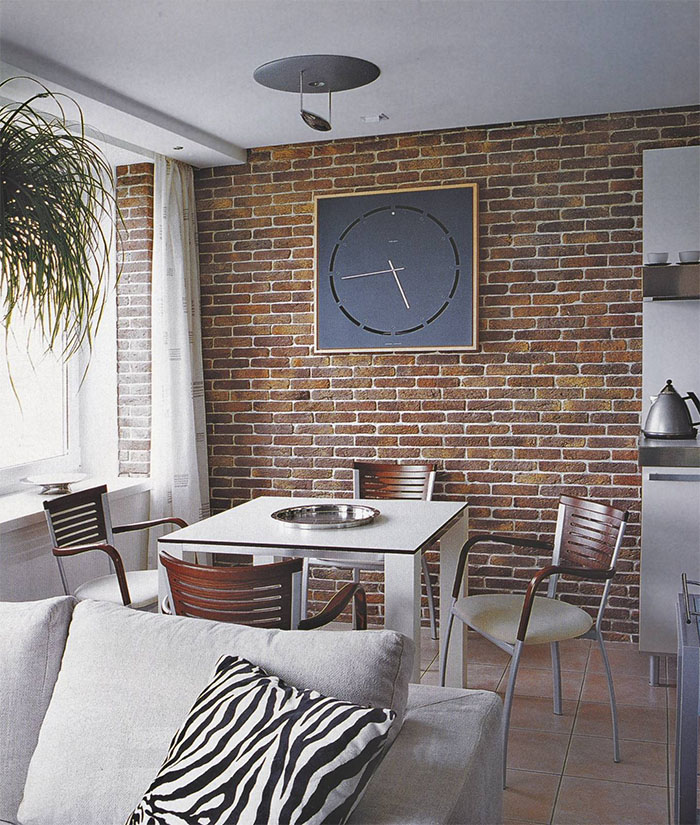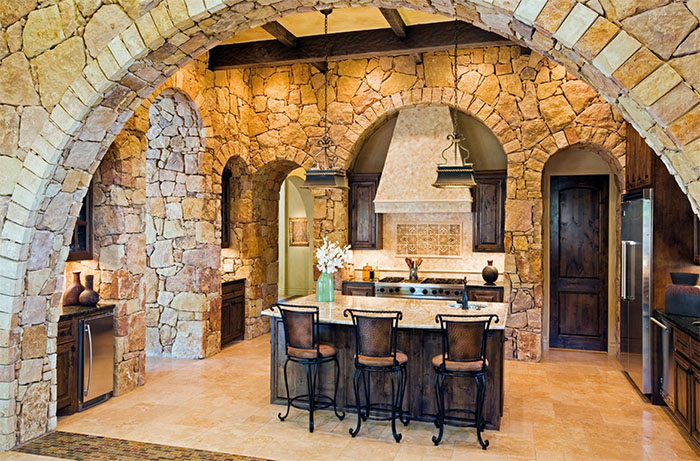Decorating the kitchen with decorative stone: ideal solution
The kitchen has a special atmosphere, and plays a significant role in the house. A place, where the family is united at breakfast, lunch or dinner, I want to build particularly comfortable. However, the design of the kitchen is very important functionality of finishing materials.

Decorative rock for interior decoration will easily cope with the task. This material has the practicality and will fit into any design. Decorative stone in the interior give the kitchen a cozy patina of antiquity and dimensions.
Artificial or decorative stone - a replica of the natural. In appearance it resembles a tile, front side which mimics the texture and color of natural material, and the interior - smooth. Such tiles is performed from solutions with the addition of mineral fillers and special hardeners. As a basis of plaster, sand with cement, acrylic resin, etc.. To impart greater resemblance to the natural prototype is added to a solution of natural stone chippings.
When laying is better to use special adhesives, but not classic grout. Adhesive solutions provided with additives, increases the reliability and durability of furnish.
Types of decorative stone
Finishing decorative stone in the apartment gives the room a rich look. And it does not matter, how to use the material - natural or artificial. Artificial stone can not be distinguished from natural, so naturally he looks.
To ensure the similarity pavement with natural enough to choose the appropriate form and dyes. A functional material depends on the composition of the mixture, from which it is made.
Finishing stone wall inside the apartment differs in the starting material and a method of manufacturing:
- ceramic,
- plaster tin,
- concrete molded,
- reinforced concrete,
- polyester with mineral filler,
- cast acrylic,
- liquid.
Ceramic is characterized by, that in the production process is burned at a high temperature. The basis of the mixture - clay. Advantages of the finished product: strength, resistance to temperature extremes, environmental friendliness.

gypsum tin (or cast) It can be done at home. Advantages of the finished product: strength, environmental friendliness, availability. Lack of products - necessary for the kitchen moisture gets only with additional special means of processing.
concrete tin (or cement-sand) You can also do at home. Resistant to frost.
reinforced concrete (or monumental) free molding is subject to the production of one unit. Most often made directly at the point of use. A particularly durable and resistant to moisture. This method is used in the production of boulders and cobbles.
Polyester with mineral filler exceeds even the natural analogues of practicality. The cost of the finished product above, since the production process is relatively difficult - solidification takes place in a vacuum at a high temperature. For the manufacture in the home is not suitable.
Cast acrylic stone cold curing is carried out in the same, like plaster. One of the advantages - you can wash any detergent, because the coating is resistant to chemical attack. Increased resistance to damage and durability - undoubted advantages of this coating.
liquid stone It is based on a gel-acrylic binder - gelcoat. Mechanical properties inferior to the cast, but it can be used to perform the most complex elements of the interior.
Regardless of the initial component mixture, there are many additives, that increase the functionality of the finished product.
Benefits stone cladding
Artificial decorative stone for interior decoration is not only the external beauty of the natural counterpart. According to its practicality wall decoration decorative stone benefits significantly when compared to other materials and even natural stone.
Availability. Decorating the kitchen with decorative stone - a simple and inexpensive way to create a custom design. He accurately replicates the natural material, but much cheaper due to technology.
Durability. Lining the walls with decorative stone will not only create a beautiful interior. The mixture for manufacturing artificial stone includes additives, increasing the wear resistance and resistance to mechanical damage.

Environmentally friendly. To create an artificial stone using eco-friendly materials - sand, clay, gypsum and t.p.
easy installation. Decorative stone on the wall in the room is laid on the principle of a conventional tile. The hardest part - just lay the first row. But this task can easily cope newcomer, if it is to comply with the rules laying.
easy care. Artificial stone in the kitchen is used in problem areas - over the stove, table or sink. Simple wet cleaning - and traces of grease and grime is gone.
application ideas
Artificial stone for interior decoration the walls of the house is appropriate in any room. But its functionality leaves no doubt, the ideal place for decorating will be a kitchen. Decorative stone in the kitchen will allow profitable beat work areas, hide flaws and highlight the dignity of premises.
Better to use artificial stone for finishing some details premises. If you draw walls completely, he can "eat" space, visually reduce the room.
Design with decorative stone in the kitchen allows even a small room divided into thematic zones.
The best place to finish - apron. Working area most exposed to the negative impact. The practicality of this material will allow the owner to spend less time on cleaning.
Excellent solution - hide behind artificial stone airbox. This detail of the interior an integral, but not very aesthetic kitchen attribute. Decorative trim bin in turn graceful column.
Window and door openings, decorated with decorative stone, will give a fabulous view of the kitchen space. Especially relevant is the artificial stone wall decoration, if there is no door in the kitchen.
Making a dining area - a classic of the genre. Normal dinner in the dining room with interior held in an atmosphere of comfort and warmth.
